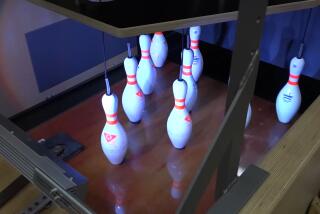China Puts Bowling in New League
- Share via
BEIJING — It was an ordinary weekday night, but things were bouncing at the Golden Altar Lanes near the 500-year-old Temple of Heaven.
Over in Lane 27, a trio of paunchy, middle-aged industrial engineers--graying hair dyed black--launched balls into parabolic orbit and watched helplessly as they crashed on the polished wood floor and swerved into the gutter. “We wanted to see what young people in Beijing do for fun these days,” said one member of the hapless group, who identified himself as Engineer Zhao.
Over in Lane 29, two men in their early 20s exchanged high fives after a strike.
Variations of the same theme, played to a thumping disco beat and backlighted in neon and Day-Glo, are occurring all over China as the world’s most populous country avidly embraces bao-ling-qiu--as the game of American-style tenpins bowling is known here.
Beijing and Shanghai now boast several 24-hour alleys, including the 50-lane Golden Altar complex, which includes a hotel, private room, VIP lanes, health club and a Sichuan-style restaurant.
A Taiwanese businessman, inspired by a California motivational guru, is building a 100-lane bowling center on the grounds of Workers’ Stadium in Beijing.
Even in remote Heilongjiang province, on the frigid Chinese border with Siberia, officials in the small city of Qiqihar have ordered a dozen new lanes.
In the United States (where surveys show that more than 53 million people played at least one game in the last year), Japan and other developed countries, bowling fever peaked years ago, leaving the game mostly a working-class pastime.
But in China, the bowling phenomenon is just entering the fast lane, favored by the emerging middle class. Young people flock to it as a dating alternative to karaoke clubs. Communist Party officials, under scrutiny from anti-corruption brigades for their lavish banqueting and entertaining, see a night of bowling as an appropriately modest gesture of hospitality for visitors.
“I come here to treat my customers,” Shanghai businessman Li Jiehua, 38, said on a recent outing to the 52-lane Gao Dian Bowling Center. “They like bowling. It’s a high-class game.”
In a surprising trade windfall for the United States, almost all of China’s bowling equipment orders--expected to top $250 million this year--come from two American companies, Brunswick and AMF. Together, they account for 80% of the new equipment business, trailed by South Korean, Canadian and Chinese companies.
According to one estimate, bowling equipment now ranks with soybeans and jet airplanes as one of the top U.S. exports to China.
“Because of its demographics, China represents the mega-market of mega-markets for bowling,” said Frederick J. Florjancic, president of Brunswick Indoor Recreation Group. “There is a strong analogy to what happened with bowling in post-World War II America. As China moves from a seven-day workweek to a six-day workweek to a five-day workweek, and as the country reaches disposable income levels, bowling has become hot.”
Commercial officials at the U.S. Embassy are so impressed that they carry bar charts showing bowling equipment sales when they appear before international business groups.
“Bowling is a perfect fit for China,” said one young diplomat. “What is happening is that incomes are exploding--but not like in America, with older people. In China, it is the young people who have the money. And look at the cities. China’s cities are urban jungles. There is no place to recreate. So bowling is a perfect fit.”
A Game of Tenpins Seen as Status Symbol
While it may take years before most families can afford their own car, bowling is already within reach. It may not yet be an everyday thing for most families. In fact, a single game generally costs more than it does in the United States. But in much the same way that a monthly trek to McDonald’s or Kentucky Fried Chicken has become a status symbol, in China, “going bowling” means that an official, businessman, romantic suitor or family has “arrived.”
“In the standard industrial classification,” a commercial diplomat said, “sporting goods is growing far faster than other categories--something like 50% to 80% a year. Bowling leads the pack.”
With more time and money on their hands, young families are looking for affordable entertainment. Some of the market has been absorbed by spectator sports. Tourism and amusement parks, which have proliferated madly across the country, also vie for their money. Lacking for most Chinese, however, are opportunities for participatory sports.
This is where bowling can fill the gap.
Sui Xiaonan, day manager at the Golden Altar Lanes, said waiting lists sometimes exceed 200 people.
On an average day, she said, the center will sell 5,000 games. At an average price of more than $2 a game, the money rolls in.
A new lane, imported from America, costs about $40,000, including pin-setting and computerized scoring equipment. At its current rate of business, Golden Altar pays off the cost of a new lane every four days.
A Different Kind of Bowling Scene
The kind of bowling scene found in China, admittedly, would not offer much comfort to Ralph Kramden or bowling legend Don Carter or the guys over at Flint No. 2 Assembly Plant.
For example, the Golden Altar Lanes offers alley fare such as spicy “Dan-Dan” (shoulder-pole bearer’s) noodles, stewed pig intestines and camphor-smoked duck washed down with Hainanese coconut juice.
Then there is the question of the private bowling chambers.
High rollers who spare no expense can show off by renting a private lane or a separate section of lanes. These VIP areas feature overstuffed furniture, wood paneling and miniskirted waitresses. Bowling here can cost up to $35 a game. Few would be shocked to learn that occasional gambling takes place in these private rooms.
“Sometimes the bet might be a Coke or a beer,” said AMF northern China representative Mark Leung. “Sometimes it might be $1,000.”
How much the bowling fad can grow is a matter of wide speculation.
Some of the larger, new facilities in Shanghai, for example, already are experiencing a decline in interest as more than 130 facilities compete for bowlers in the southern metropolis.
On a recent afternoon at the 68-lane Star City Bowling Center there, only six lanes were occupied, while a handful of other customers played pool and video games.
“We are quite disappointed,” said Eva Jiang, public relations manager of the Singapore-funded bowling center. “There are too many bowling alleys in Shanghai now. We are losing money on this project.”
But other alleys in Shanghai continue to boom, and bowling developers contend that the real room for growth is in China’s hinterlands.
“Today,” said AMF’s Leung, “bowling is just starting in the major cities and some so-called second-tier cities. We know that there are at least 3,000 of these medium-sized cities and that only 10% of them have bowling lanes. We figure that each of these cities can support at least 10 lanes. So we are talking about a minimum unrealized demand of 27,000 lanes.” In dollar value, that is more than $1 billion in equipment orders.
While bowling has seen its popularity sag in America, where there are an estimated 5 million die-hards (league members who play dozens of times in a year), those who seek to boost the sport here point to the experiences of Japan, South Korea and, particularly, Taiwan, as precedent for the China bowl syndrome.
In Japan, bowling interest peaked as the country developed in the early 1970s, reaching 125,000 lanes before crashing and stabilizing at 40,000 lanes.
South Korea and Taiwan experienced similar cycles before stabilizing at 35,000 and 25,000 lanes, respectively.
In Taiwan, which shares the same language and culture as China, the country has a ratio of about one lane for every 2,000 people. If the same ratio were to be reached in China, there would be more than 600,000 lanes--more than double the total number of lanes in the rest of the world.
Inspiration for a 100-Lane Alley
It was the Taiwan experience and a seminar by American motivational guru Anthony Robbins that inspired Alex Huang to build one of the world’s largest bowling centers on the grounds of Workers’ Stadium--a sprawling Beijing venue once known more for political rallies and public executions than for sports.
“First of all, I want to thank my teacher, Tony Robbins,” said Huang, 30. “Two years ago in Palm Springs, he told me that ‘if you want to do something, you should do it the greatest and the best.’ ”
When it is completed this winter, Huang’s 8800 Golden Bowling Lanes--so dubbed because Huang wanted the lucky association that the Chinese will make with the double eights and double zeros--will have 100 lanes and stretch almost the length of two football fields along one side of the stadium.
Bowling will succeed in China, said Huang, who tends to get spiritual about his $20-million investment, “because when you bowl indoors you will not be affected by the weather. When you bowl, you release your inner feelings.”
The Workers’ Stadium center will be the largest in a country that bowling executives believe is still vastly underbuilt.
“China today has about 15,000 lanes,” said Brunswick’s Florjancic, interviewed during one of his regular Beijing visits. “If you take into consideration its 1.2 billion people, it could end up having 400,000 lanes before it is all said and done. Minimally, you are looking at 50,000 lanes, which would make it second to the United States.”
Brunswick and AMF hope to maintain the interest here in the sport by sponsoring professional teams, tournaments and bowling-for-money television shows.
Meantime, while promoters seek to make bowling accessible to the masses, for the time being, at least, it is the keglers--not the golf or tennis players--who are the envied among the Chinese elite.
“We are China’s country club of today,” said Florjancic, smiling as he watched a Cabinet minister and his family bowl in an adjacent lane of a Brunswick-supplied alley. “Twenty years from now, it will probably be golf.”
Anthony Kuhn of The Times’ Beijing Bureau and Bao Lei of The Times’ Shanghai Bureau contributed to this report.
More to Read
Sign up for Essential California
The most important California stories and recommendations in your inbox every morning.
You may occasionally receive promotional content from the Los Angeles Times.













